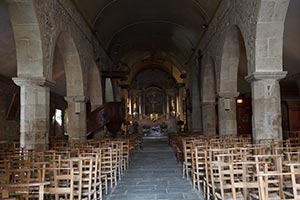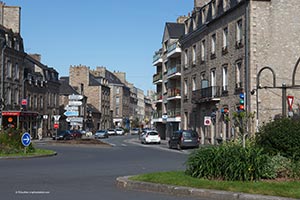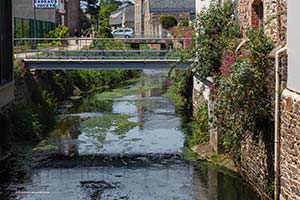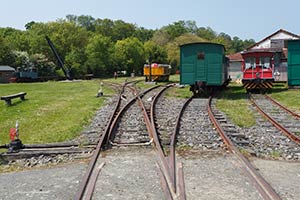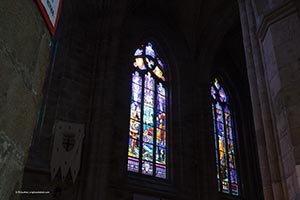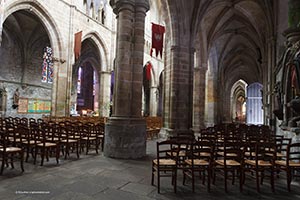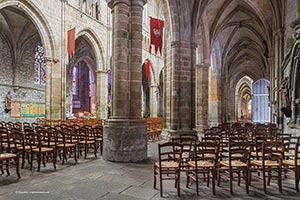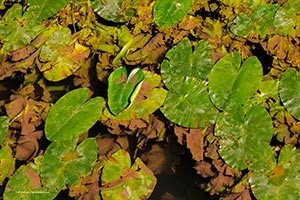Église de Lézardrieux : Problèmes liés aux photos prises à l'intérieur d'une église
Prendre des photos à l'intérieur d'une église est très difficile. Les problèmes de contraste ainsi que les déformations angulaires rendent souvent les résultats inacceptables.
Il n'y a pas de recette magique, hormis une préparation soignée, un trépied pour éviter un ISO beaucoup trop élevé et un post-traitement délicat avec Photoshop à la clef.
On peut coupler tout ça avec la technique appelée gamme dynamique étendue ou l'équivalent, une expression pour le moins ambiguë. S'il est acceptable d'utiliser HDR en français, dire high dynamic range plutôt que gamme dynamique étendue est pour le moins discutable.
Dans la méthode gamme dynamique étendue, c'est la scène qui a une gamme dynamique trop grande pour le capteur et non l'inverse. On prend donc trois, ou même cinq photos simultanées à différentes expositions pour en faire à l'aide d'algorithmes plus ou moins complexes une image à gamme dynamique réduite qu'un écran et une imprimante peuvent gérer sans problème.
Certains appareils produisent automatiquement une image à gamme dynamique réduite à partir de la méthode dite gamme dynamique étendue. C'est le cas en particulier du iPhone 5 qui utilise cette méthode de façon entièrement transparente pour donner des images étonnantes pour des scènes qui autrement présenteraient des zones brûlées et des zones sombres sans aucun détail.
On n'arrête pas le progrès. Parfois.
Je n'ai pas utilisé cette méthode ici, ce qui montre la supériorité du format RAW sur le format jpeg qui n'aurait pas permis ces résultats.
Dans un prochain billet, je donnerai quelques indications sur les principales étapes du post-traitement. :-)
Roger Gauthier, Le photographe venu du froid
••••••••••••••••••••••••••••
Lézardieux Church: Problems With Photos Taken Inside A Church
Taking pictures in a church is a very difficult task indeed. Very high contrasts and angular deformations often yield poor pictures.
There is no magical recipe except a careful preparation, a tripod in order to use a low ISO, and a very delicate post-processing job using Photoshop.
You could use on top of that the High Dynamic Range technique (HDR), a confusing expression if there is one as we will see below.
In the HDR method, it's the scene you're shooting that has too great a dynamic range for the camera's sensor. It's not the other way around… One will usually take three rapid shots, sometimes five (the camera will do that for you automatically), in order to produce a single image with a reduced dynamic range, using some complex algorithms. This final image can then be easily treated using a good display and printer.
Some cameras will do this HDR trick from a to z for you without any intervention from your part except choosing HDR mode. This is the case for the iPhone 5, among others, which will give you a very good image for scenes that otherwise would present burned out highlights and shadows without any detail.
There is no stopping progress. Sometimes.
I did not use the HDR method here, and this shows you how superior the RAW format is compared to jpeg. It would have been almost impossible to obtain such results in jpeg mode, not without noise and whatnot.
In a future post, I will give some info about the post-processing involved in this type of photography.
Roger Gauthier, The Photographer who came from the cold
Les photos traitées sont à gauche. Les photos originales, sans post-traitement, sont à droite / Final Photos Are At The Left. Original Pictures, Without Post-Processing, Are At The Right



